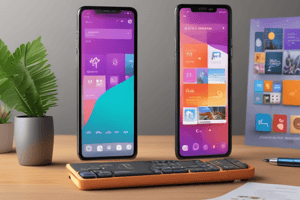Podcast
Questions and Answers
What are the elements called that can be added to make a canvas app interactive and functional?
What are the elements called that can be added to make a canvas app interactive and functional?
- Controls (correct)
- Utilities
- Buttons
- Features
Which method is NOT mentioned for customizing controls in Power Apps?
Which method is NOT mentioned for customizing controls in Power Apps?
- Writing custom expressions in the formula bar
- Modifying settings in the Properties tab
- Using the toolbar
- Employing third-party plugins (correct)
What term is used to refer to the settings that can be adjusted for controls in Power Apps?
What term is used to refer to the settings that can be adjusted for controls in Power Apps?
- Properties (correct)
- Features
- Attributes
- Options
What is the purpose of the New Screen button in Power Apps?
What is the purpose of the New Screen button in Power Apps?
Which routine categories are mentioned in the provided content?
Which routine categories are mentioned in the provided content?
What is the effect of adding a new screen in Power Apps?
What is the effect of adding a new screen in Power Apps?
Where can you find the hierarchical list of controls in Power Apps?
Where can you find the hierarchical list of controls in Power Apps?
What will happen when you select a label control under Screen2?
What will happen when you select a label control under Screen2?
Which action is performed to add a new screen in Power Apps?
Which action is performed to add a new screen in Power Apps?
What is indicated by the box with handles surrounding a label in Power Apps?
What is indicated by the box with handles surrounding a label in Power Apps?
What is the recommended naming convention for controls in Power Apps?
What is the recommended naming convention for controls in Power Apps?
Which of the following is an example of a proper control name in Power Apps?
Which of the following is an example of a proper control name in Power Apps?
Why is it important to follow a consistent naming convention for controls?
Why is it important to follow a consistent naming convention for controls?
What type of control should the name start with when following the suggested naming convention?
What type of control should the name start with when following the suggested naming convention?
What is NOT a benefit of using camel case in control naming?
What is NOT a benefit of using camel case in control naming?
What is the purpose of using a consistent naming convention for controls in Power Apps?
What is the purpose of using a consistent naming convention for controls in Power Apps?
Which of the following abbreviations is NOT used for control naming in Power Apps?
Which of the following abbreviations is NOT used for control naming in Power Apps?
What does the abbreviation 'cmb' stand for in Power Apps?
What does the abbreviation 'cmb' stand for in Power Apps?
What is the recommended starting format for naming controls like buttons and labels?
What is the recommended starting format for naming controls like buttons and labels?
Which control abbreviation would correctly represent a drop-down menu in Power Apps?
Which control abbreviation would correctly represent a drop-down menu in Power Apps?
Flashcards
Controls
Controls
User interface elements that make an app interactive and functional. They can be customized to adjust their appearance and behavior.
Properties
Properties
The settings of a control that determine its appearance or behavior.
Adding a New Screen
Adding a New Screen
Adding a new screen to create a new page within your app.
Configuring Controls
Configuring Controls
Signup and view all the flashcards
Methods to Configure Controls
Methods to Configure Controls
Signup and view all the flashcards
What is the "New Screen" button used for?
What is the "New Screen" button used for?
Signup and view all the flashcards
What is a Screen in Power Apps?
What is a Screen in Power Apps?
Signup and view all the flashcards
What is the left navigation pane for in Power Apps?
What is the left navigation pane for in Power Apps?
Signup and view all the flashcards
What is the "Select Box" in Power Apps?
What is the "Select Box" in Power Apps?
Signup and view all the flashcards
What is the control's hierarchical list?
What is the control's hierarchical list?
Signup and view all the flashcards
Control Naming Convention
Control Naming Convention
Signup and view all the flashcards
Consistent Naming Convention
Consistent Naming Convention
Signup and view all the flashcards
Type Descriptor
Type Descriptor
Signup and view all the flashcards
Control Purpose
Control Purpose
Signup and view all the flashcards
Camel Case
Camel Case
Signup and view all the flashcards
What are control properties?
What are control properties?
Signup and view all the flashcards
How do you configure controls?
How do you configure controls?
Signup and view all the flashcards
What are control abbreviations?
What are control abbreviations?
Signup and view all the flashcards
Why is control naming important?
Why is control naming important?
Signup and view all the flashcards
Study Notes
Adding & Configuring Controls in Power Apps
- Power Apps allows for interactive and functional user interfaces (UI) by adding different types of UI elements, called controls.
- These controls can be customized in various ways: through the toolbar, by modifying settings in the Properties tab, or by creating custom expressions in the formula bar.
- The settings adjusted are referred to as properties.
Adding a Screen
- To add a new screen, click the New Screen button.
- Choose your desired screen type from various templates.
- The screen type suits the app's specific needs.
- Newly created screens are automatically named (e.g., Screen2) and appear in the left navigation pane.
- This pane provides a hierarchical list of all app controls.
Object Tree View
- Navigate to the Insert tab to select Label.
- New label controls appear under Screen 2, situated in the hierarchical list.
- A label is surrounded by a box with handles when selected.
- Click/tap outside the label to deselect it.
- Select the label in the screen or from the hierarchical list of controls.
Renaming a Control
- Hover over a control to show an ellipsis (...), then click it.
- Select Rename to type a unique and descriptive control name.
Naming Convention
- Use camel case for control names.
- Use a three-character type descriptor (e.g., btn for buttons).
- Followed by a description of the control's purpose.
- This improves control identification and formula building, also promoting better searchability.
Deleting a Control
- Hover over the control to remove, then click the ellipsis (...) button.
- Select Delete to remove the control.
- For non-screen controls, select the control directly on the screen and press Delete.
Re-ordering Screens
- Hover over the screen to reorder.
- Click the ellipsis (...) and select Reorder.
- Choose from the options (Bring to Front, Bring Forward, Send Backward...).
- This adjusts the screen's stacking order relative to other controls.
Moving or Resizing Controls
- Select the control and hover over its center until a four-headed arrow appears.
- Drag the control to change its position.
- Select the control and hover over any handle in the selection box until a two-headed arrow appears.
- Drag the handle to adjust the control size.
Configuring Controls in the Properties Pane
- Use the Properties pane to customize specific controls.
- Change properties like text, visibility, and positioning.
Studying That Suits You
Use AI to generate personalized quizzes and flashcards to suit your learning preferences.




